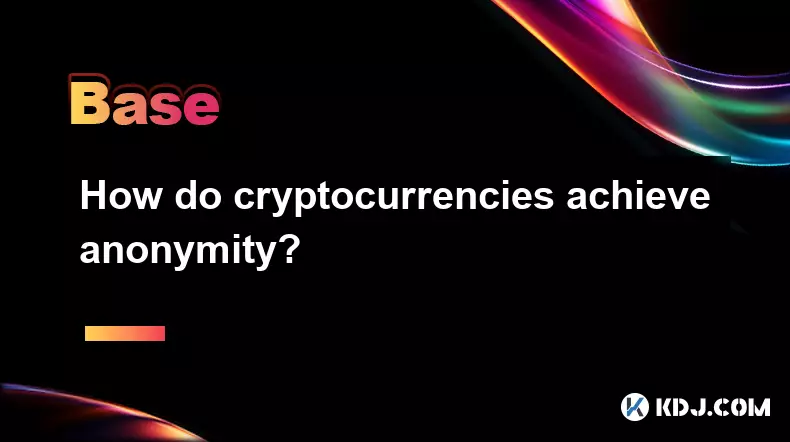-
 bitcoin
bitcoin $100977.009184 USD
-2.05% -
 ethereum
ethereum $3282.009150 USD
-3.23% -
 tether
tether $0.999813 USD
-0.02% -
 xrp
xrp $2.208254 USD
-4.89% -
 bnb
bnb $951.411089 USD
0.55% -
 solana
solana $155.761205 USD
-2.84% -
 usd-coin
usd-coin $1.000217 USD
0.02% -
 tron
tron $0.284475 USD
-1.28% -
 dogecoin
dogecoin $0.162363 USD
-1.53% -
 cardano
cardano $0.533988 USD
-0.47% -
 hyperliquid
hyperliquid $39.174339 USD
-3.22% -
 chainlink
chainlink $14.724828 USD
-1.16% -
 bitcoin-cash
bitcoin-cash $477.297986 USD
-1.28% -
 zcash
zcash $554.227426 USD
17.30% -
 ethena-usde
ethena-usde $0.998995 USD
-0.03%
How do cryptocurrencies achieve anonymity?
Cryptocurrencies offer varying anonymity through techniques like coin mixing, privacy-focused protocols (e.g., Monero, Zcash), and network obfuscation, though true anonymity requires careful operational security.
Oct 13, 2025 at 11:01 pm

Understanding the Foundations of Cryptocurrency Anonymity
1. Cryptocurrencies achieve varying degrees of anonymity through cryptographic techniques embedded in their protocols. While many assume all digital currencies offer complete privacy, the reality is more nuanced. Bitcoin, for instance, operates on a transparent blockchain where every transaction is publicly recorded. However, user identities are not directly tied to wallet addresses, creating a layer of pseudonymity rather than full anonymity.
2. The use of public and private key cryptography ensures that only the owner of a private key can authorize transactions from a given address. This mechanism prevents unauthorized access while allowing users to remain unidentified as long as their wallet addresses are not linked to real-world identities.
3. When users transact using new addresses for each operation, it becomes significantly harder to trace patterns back to a single individual. This practice, known as address rotation, enhances privacy by reducing linkability between transactions.
4. Network-level protections such as connecting through Tor or other anonymizing networks further obscure the origin of transactions. These tools mask IP addresses, making it difficult for observers to associate blockchain activity with specific devices or locations.
5. Some blockchain explorers and analytics firms attempt to de-anonymize users by clustering addresses and analyzing transaction flows. Despite these efforts, well-practiced operational security can maintain a high degree of privacy even on transparent ledgers.
Coin Mixing and Transaction Obfuscation
1. One of the most direct methods to enhance anonymity is through coin mixing, also known as tumbling. Services like CoinJoin combine multiple users’ transactions into a single batch, breaking the clear trail between sender and receiver.
2. In a typical mix, several participants send their coins into a shared pool, which then redistributes them using new outputs. Because inputs and outputs are scrambled, external observers cannot easily determine which output corresponds to which input.
3. This process effectively severs the transaction graph linkage, making forensic analysis far less reliable. Reputable mixing services do not store logs and often require minimal personal information, reducing custodial risk.
4. Some wallets integrate mixing protocols directly, allowing users to participate without relying on third-party servers. These decentralized approaches reduce trust requirements and improve resistance to censorship.
5. Regulatory scrutiny has increased around mixing services due to their potential misuse in illicit finance. However, privacy advocates emphasize that financial anonymity is a legitimate need for individuals operating in repressive regimes or sensitive industries.
Dedicated Privacy-Focused Cryptocurrencies
1. Certain cryptocurrencies are explicitly designed for strong anonymity. Monero, Zcash, and Dash incorporate advanced privacy features at the protocol level, offering confidentiality by default or through optional shielding.
2. Monero uses ring signatures, confidential transactions, and stealth addresses to conceal sender, receiver, and transaction amount. Ring signatures allow a user to sign a transaction on behalf of a group, making it impossible to identify which member authorized the spend.
3. Stealth addresses ensure that recipients receive funds at one-time-use addresses generated dynamically, preventing balance tracking. These mechanisms work together to create a highly opaque transaction ledger.
4. Zcash offers selective transparency through zk-SNARKs—zero-knowledge proofs that validate transactions without revealing any details. Users can choose between transparent and shielded addresses, balancing compliance needs with privacy preferences.
5. Dash employs PrivateSend, a coin-mixing service built into its network. It utilizes a chained mixing approach across multiple nodes to anonymize funds incrementally, enhancing resistance to chain analysis over time.
Challenges and Limitations in Achieving True Anonymity
1. Even with robust technical safeguards, human behavior often undermines anonymity. Reusing addresses, linking wallets to identity-revealing platforms, or transacting with KYC-regulated exchanges can expose users.
2. Chain analysis firms leverage machine learning and heuristic models to infer relationships between addresses. Large-scale transaction monitoring tools are now standard in law enforcement and compliance workflows.
3. Network-level surveillance can compromise privacy if users fail to protect their IP addresses or device fingerprints. Running nodes over unsecured connections leaves digital footprints that adversaries may exploit.
4. Regulatory pressure continues to target privacy tools, with some jurisdictions restricting access to anonymizing technologies. This creates geographic disparities in the availability and legality of certain privacy practices.
5. No system is entirely immune to attack. Advances in quantum computing, protocol exploits, or implementation flaws could potentially weaken current anonymity guarantees in the future.
Frequently Asked Questions
What is the difference between pseudonymity and true anonymity in crypto?Pseudonymity means actions are tied to an identifier (like a wallet address) that isn’t directly linked to a real name. True anonymity ensures no feasible way exists to connect a transaction to an individual, even with extensive analysis.
Can law enforcement trace private cryptocurrency transactions?Yes, in many cases. While privacy coins and mixers complicate investigations, authorities use behavioral analysis, exchange cooperation, and network monitoring to uncover identities. Complete anonymity requires disciplined usage and additional protective layers.
Do all wallets support privacy features?No. Most standard wallets provide basic functionality without built-in privacy tools. Users seeking enhanced anonymity must choose specialized wallets that support features like CoinJoin, Tor integration, or compatibility with privacy-focused blockchains.
Is using a mixer service legal?The legality varies by jurisdiction. In some countries, using mixers is permitted as part of financial privacy rights. Others classify such services as money laundering facilitators and prohibit their use, especially when intended to evade oversight.
Disclaimer:info@kdj.com
The information provided is not trading advice. kdj.com does not assume any responsibility for any investments made based on the information provided in this article. Cryptocurrencies are highly volatile and it is highly recommended that you invest with caution after thorough research!
If you believe that the content used on this website infringes your copyright, please contact us immediately (info@kdj.com) and we will delete it promptly.
- BlockDAG, Avalanche, Dogecoin: Crypto's Leading Trio in 2025
- 2025-11-07 22:05:01
- Layer 2 Coins: Will There Be a Potential Explosion by 2026?
- 2025-11-07 16:50:02
- Filecoin, ICP, and the AI Infrastructure Renaissance: Is History Repeating?
- 2025-11-07 16:50:02
- Bitcoin's Wild Ride: Surges, Zeros, and the Search for Stability
- 2025-11-07 17:05:01
- XRP, Bitcoin, and the Rally: What's the Deal, New York?
- 2025-11-07 17:25:01
- Filecoin, DePIN, and a Technical Breakout: What's the Buzz?
- 2025-11-07 17:05:01
Related knowledge

How does a crypto insurance protocol work?
Nov 08,2025 at 12:39am
Understanding Crypto Insurance Protocols1. A crypto insurance protocol operates by offering financial protection against losses incurred from digital ...

What is a decentralized storage network and how does it compare to cloud services?
Nov 07,2025 at 11:59pm
Understanding Decentralized Storage Networks1. A decentralized storage network distributes data across a peer-to-peer infrastructure rather than relyi...

What is a factory contract and how is it used to deploy other contracts?
Nov 08,2025 at 04:20am
Understanding Factory Contracts in Blockchain Development1. A factory contract is a smart contract designed to create and deploy other smart contracts...

What is an address poisoning scam and how can you prevent it?
Nov 08,2025 at 02:20am
Understanding Address Poisoning Scams in the Crypto Space1. An address poisoning scam is a deceptive tactic used by malicious actors within the crypto...

What is liquid restaking and how does it build upon the concept of staking?
Nov 07,2025 at 06:19pm
Bitcoin’s Role in Decentralized Finance Evolution1. Bitcoin remains the cornerstone of decentralized finance, setting benchmarks for security and netw...

What is a concentrated liquidity position and how does it improve capital efficiency?
Nov 07,2025 at 06:00pm
Understanding Concentrated Liquidity Positions1. A concentrated liquidity position allows liquidity providers to allocate their capital within a speci...

How does a crypto insurance protocol work?
Nov 08,2025 at 12:39am
Understanding Crypto Insurance Protocols1. A crypto insurance protocol operates by offering financial protection against losses incurred from digital ...

What is a decentralized storage network and how does it compare to cloud services?
Nov 07,2025 at 11:59pm
Understanding Decentralized Storage Networks1. A decentralized storage network distributes data across a peer-to-peer infrastructure rather than relyi...

What is a factory contract and how is it used to deploy other contracts?
Nov 08,2025 at 04:20am
Understanding Factory Contracts in Blockchain Development1. A factory contract is a smart contract designed to create and deploy other smart contracts...

What is an address poisoning scam and how can you prevent it?
Nov 08,2025 at 02:20am
Understanding Address Poisoning Scams in the Crypto Space1. An address poisoning scam is a deceptive tactic used by malicious actors within the crypto...

What is liquid restaking and how does it build upon the concept of staking?
Nov 07,2025 at 06:19pm
Bitcoin’s Role in Decentralized Finance Evolution1. Bitcoin remains the cornerstone of decentralized finance, setting benchmarks for security and netw...

What is a concentrated liquidity position and how does it improve capital efficiency?
Nov 07,2025 at 06:00pm
Understanding Concentrated Liquidity Positions1. A concentrated liquidity position allows liquidity providers to allocate their capital within a speci...
See all articles





















![The Graph Price Prediction [GRT Crypto Price News Today] The Graph Price Prediction [GRT Crypto Price News Today]](/uploads/2025/11/07/cryptocurrencies-news/videos/690d4df44fe69_image_500_375.webp)




















































